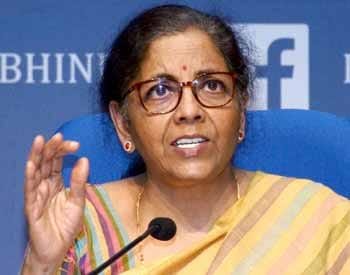Finance Minister Nirmala Sitharaman defends the Budget 2024, addressing opposition claims about state allocations and clarifying that the absence of a state’s name doesn’t mean it wasn’t funded. Explore her detailed rebuttal and historical context.
Introduction
INVC NEWS
New Delhi : In a recent debate surrounding the Indian Budget 2024, Finance Minister Nirmala Sitharaman found herself at the center of a storm of accusations. Critics argued that the absence of certain state names in the budget signified a lack of funding for those regions. Sitharaman, however, has firmly rebutted these allegations. Her defense not only underscores her administration’s stance but also highlights a historical perspective that reveals a recurring pattern in India’s budget allocations. This article delves into Sitharaman’s counterarguments, explores the historical context of budgetary allocations, and sheds light on the broader implications of state funding in India’s financial framework.
Sitharaman’s Rebuttal: The Core Argument
The Absence of State Names: A Misconception?
During the discussion on Budget 2024, Sitharaman made a pointed observation: the mere omission of a state’s name from the budget document does not equate to a lack of financial allocation. This assertion was made to challenge the opposition’s claims and clear up what she considers a significant misconception. Here’s a breakdown of her argument:
- Historical Patterns: Sitharaman emphasized that similar patterns were evident in past budgets. For instance:
- 2004-05 Budget: No state names were listed.
- 2009-10 Budget: Only Uttar Pradesh and Bihar were mentioned.
- 2010-11 Budget: 19 states did not appear.
- 2014-15 Budget: 10 states were left out.
- The Question of Allocation: She posed a rhetorical question to her critics: Did the states not listed in previous budgets receive no funds? According to Sitharaman, this is clearly not the case.
Challenging Historical Practices
Sitharaman’s rebuttal was also a critique of past administrations. By referring to former Prime Minister Manmohan Singh’s tenure, she highlighted that the absence of state names has historically not impacted fund distribution. This historical reference aims to contextualize current practices and refute claims of unfair treatment in the present budget.
Financial Allocation: Understanding the Mechanics
How Funds Are Allocated
Understanding the mechanics of financial allocations in India’s budget can help demystify Sitharaman’s defense. Here’s a simplified explanation:
- Central vs. State Budgets: The central budget outlines allocations for various schemes and programs, which are often distributed to states based on specific criteria.
- Program-Based Allocation: Funds are frequently allocated based on programs rather than direct state mentions. For instance, a national health initiative might receive funding that is distributed across states based on need, without explicitly naming each state in the budget.
The Role of Budget Documents
Budget documents are comprehensive but often streamlined. The absence of a state’s name in the primary document does not preclude the existence of financial support. Instead, these documents may focus on broad allocations or overarching schemes rather than detailing state-specific expenditures.
The Opposition’s Perspective
Claims of Disparity
The opposition argues that the lack of state names signifies a deliberate exclusion or neglect. This perspective posits that visible mentions are crucial for transparency and perceived fairness in fund distribution.
Counterarguments and Evidence
Critics of the opposition’s stance argue that the budget’s transparency lies in the detailed allocation reports and subsequent financial audits, rather than in the names listed in the preliminary documents.
Historical Context: A Closer Look
Previous Budgets: What History Reveals
The historical patterns Sitharaman refers to indicate that budget documents have often omitted state names without affecting the allocation of funds. Here’s a snapshot of previous practices:
- 2004-05: The budget did not list any states, yet funds were allocated through various central schemes.
- 2009-10: Limited state mentions did not imply that other states were neglected; instead, funding followed program-based distribution.
Lessons from the Past
The recurring omission of state names in budget documents suggests a historical trend where detailed allocations were often managed outside the primary budget documents. This historical perspective can help address current criticisms and provide a clearer understanding of how funds are actually distributed.
FAQs
What does it mean if a state’s name is not mentioned in the budget?
The absence of a state’s name does not imply a lack of funding. Allocations can be made through broader programs or central schemes that do not specify individual state names in the primary budget document.
How are funds typically distributed to states?
Funds are usually allocated based on specific programs or needs rather than direct state mentions. Central schemes often distribute resources across states based on criteria like population, need, and existing infrastructure.
Has this omission been a common practice in past budgets?
Yes, historical data shows that budgets have frequently omitted state names without impacting financial allocations. This trend suggests that the absence of state names in the budget does not necessarily reflect the actual distribution of funds.
Finance Minister Nirmala Sitharaman’s defense of Budget 2024 against opposition claims sheds light on a critical aspect of financial allocations. Her assertion that the absence of a state’s name in the budget does not equate to a lack of funding is backed by historical precedents and a broader understanding of budgetary practices. By contextualizing current budgetary debates within historical frameworks, Sitharaman not only challenges opposition claims but also reinforces the need for a nuanced understanding of how public funds are managed and allocated.
As we navigate the complexities of budgetary allocations, it’s essential to consider both historical practices and the mechanics of fund distribution. Sitharaman’s insights offer a valuable perspective on ensuring transparency and fairness in financial governance, highlighting the importance of looking beyond surface-level documents to grasp the true nature of state funding.
In the end, while budget documents may evolve, the principles of allocation and funding remain rooted in broader mechanisms designed to address the needs of all states, regardless of their mention in the budget.













